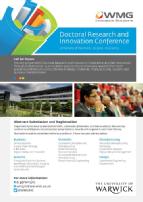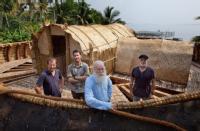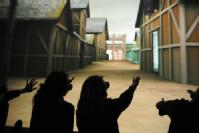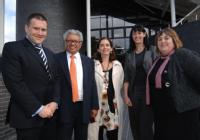WMG News
Call for Papers - WMG Doctoral Research and Innovation Conference
 The 2nd annual WMG Doctoral Research and Innovation Conference, entitled ‘Innovation through Collaboration’, is an excellent opportunity to showcase research from both academia and industry across themes in design, materials, manufacturing, systems and business transformation.
The 2nd annual WMG Doctoral Research and Innovation Conference, entitled ‘Innovation through Collaboration’, is an excellent opportunity to showcase research from both academia and industry across themes in design, materials, manufacturing, systems and business transformation.
Organised by doctoral students, the conference will be held in the International Digital Laboratory on 30th June - 1st July, with an evening social event on the 30th.
Papers and poster presentations will take place across a wide variety of topics and awards will be presented in each theme.
Abstracts should be submitted online by 31st March.
WMG helps to shed new light on ‘The Real Noah’s Ark ‘

Researchers at WMG, University of Warwick, used 3D scanning and visualisation technology to help Dr Irving Finkel, the world’s foremost expert on ancient Babylonian languages, decipher a 4000-year-old tablet that sheds new light on the iconic biblical tale of Noah's Ark.
‘The Real Noah’s Ark’, shown on Channel 4, Sunday 14th September, documented the astonishing story of this significant find and Dr Finkel’s incredible journey of discovery. The ancient clay tablet, discovered on a mantelpiece in a UK suburban home and handed to the British Museum, is inscribed with the world's oldest language, cuneiform. It tells the story of a Noah-like figure and a great flood, giving detailed instructions on how to build an ark. However, due to its incredible age and some understandable wear and tear, parts of the tablet are difficult to read.
Having spent 20 years translating the tablet Dr Finkel, Assistant Keeper of Ancient Mesopotamian Scripts, Languages and Cultures at the British Museum, set out to show that the biblical narrative originated from stories that had been embedded in Sumerian and Babylonian society and literature for thousands of years. He also cast new light on the shape of the ark, believing that it was round; closer in style to ancient coracles than the traditional long seafaring boat of popular imagination. After all, it didn’t necessarily need to sail anywhere, it just needed to float until the floodwater retreated.
WMG’s Professor Mark Williams assisted Dr Finkel with his detailed interpretation of the tablet by scanning it using cutting edge X-ray Micro-CT and 3D Laser Scanning technology, and projecting the image onto the UK’s highest resolution 3D power wall. The immersive technology allowed Dr Finkel to view the tablet from all angles and in high definition, revealing previously undecipherable characters and confirming his suspicions that the vessel being described was indeed round.
Midlands pupils first to see virtual reality recreation of Lunt Fort as it was in Roman times
 A group of schoolchildren from Coventry’s Westwood Academy have become the first members of the public to see a specially commissioned 3D Virtual Reality model of Warwickshire’s Lunt Fort.
A group of schoolchildren from Coventry’s Westwood Academy have become the first members of the public to see a specially commissioned 3D Virtual Reality model of Warwickshire’s Lunt Fort.
They were invited to WMG to see how the fort would have looked during the height of use by Roman soldiers between 60 and 80AD.
3D Technology helps book Coventry company’s business class seats on latest plane
A Coventry company, which has designed a high tech business class aeroplane seat, is winning the attention of major plane companies thanks to technology at WMG, part of the University of Warwick, which allows them to show customers virtual reality simulations of exactly how those seats will look within their planes.
Sion Simon MP Visits WMG's International Digital Laboratory
Siôn Simon MP visited WMG's International Digital Laboratory in September. The Minister for Creative Industries at the Department for Culture, Media and Sport was welcomed by Professor Lord Bhattacharyya, Director of WMG, and toured the Digital Lab meeting Professor Sadie Creese, Director of e-Security, and Professor Lucy Hooberman, Director Digital Media and Innovation.
Researchers using parallel processing computing could save thousands by using an Xbox
Dr Simon Scarle, a researcher at the University of Warwick’s International Digital Laboratory (WMG), wished to model how electrical excitations in the heart moved around damaged cardiac cells in order to investigate or even predict cardiac arrhythmias (abnormal electrical activity in the heart which can lead to a heart attack). To conduct these simulations using traditional CPU based processing one would normally need to book time on a dedicated parallel processing computer or spend thousands on a parallel network of PCs.
WMG researchers creating 'virtual cocoon'
Scientists bring 2000-year-old painted warrior to life
A 2000-year-old painted statue is being restored to her original glory by scientists from WMG at the University of Warwick, the University of Southampton, and the Herculaneum Conservation Project.
State of the art scanner gives new life to classic cars
STATE-OF-THE ART SCANNER GIVES NEW LIFE TO CLASSIC CARS**TUESDAY 13 NOVEMBER  ** Britain has a unique motoring heritage – most of it preserved in museums – but researchers at WMG are to use high-technology to breathe new life into our classic autos. WMG’s Craftsmanship team, based at the University of Warwick, have recently installed a £350,000 laser measurement machine, supplied by Metris UK, that can accurately measure – to the nearest micron – anything from the smallest component up to full size cars. And on Tuesday 13 November they will demonstrate this technology by laser scanning a priceless Lea Francis Hyper – winner of the 1928 Ulster TT race – to develop a unique computer model of the car.
** Britain has a unique motoring heritage – most of it preserved in museums – but researchers at WMG are to use high-technology to breathe new life into our classic autos. WMG’s Craftsmanship team, based at the University of Warwick, have recently installed a £350,000 laser measurement machine, supplied by Metris UK, that can accurately measure – to the nearest micron – anything from the smallest component up to full size cars. And on Tuesday 13 November they will demonstrate this technology by laser scanning a priceless Lea Francis Hyper – winner of the 1928 Ulster TT race – to develop a unique computer model of the car.

